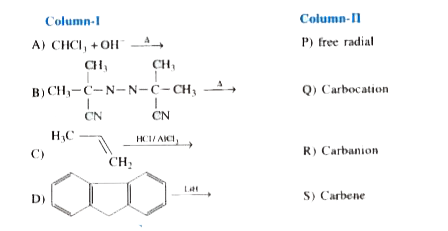Heterolysis of C-Cl bond producesSolution in Telugu
Two carbanions
Two carbonium ions
Two free radical S
One cation and one anion
The correct Answer is:D
Step by step video, text & image solution for Heterolysis of C-Cl bond produces by Chemistry experts to help you in doubts & scoring excellent marks in Class 11 exams.
Topper's Solved these Questions
- BOOK - AAKASH SERIESCHAPTER - GENERAL ORGANIC CHEMISTRYEXERCISE - Objective Exercise -282videos
GENERAL ORGANIC CHEMISTRY
- BOOK - AAKASH SERIESCHAPTER - GENERAL ORGANIC CHEMISTRYEXERCISE - Practice Exercise80videos
GENERAL ORGANIC CHEMISTRY
- BOOK - AAKASH SERIESCHAPTER - GENERAL ORGANIC CHEMISTRYEXERCISE - Subjective Exercise -8120videos
GENERAL ORGANIC CHEMISTRY
- BOOK - AAKASH SERIESCHAPTER - ENVIRONMENTAL CHEMISTRYEXERCISE - EXERCISE ON PASSAGE (PASSAGE-III)5videos
ENVIRONMENTAL CHEMISTRY
- BOOK - AAKASH SERIESCHAPTER - HYDROCARBONSEXERCISE - ADDITIONAL PRACTICE SHEET ( LEVEL-II (PRACTICE SHEET (ADVANCED) (MATRIX MATCHING TYPE QUESTIONS)))5videos
HYDROCARBONS
Similar Questions
The compound containing sp sp2 and sp3 hybridised carbon atoms in 1:2:3 ratio is
02:09View SolutionThe compound CH3−CH∣CH3−CH∣CH3−CH3 contains
01:38View SolutionExplain the estimation of nitrogen of an organic compound by
(a) Dumas method and (b) Kjeldahl's method03:07View SolutionOzone layer acts as one of the most important life support system. The major cause of ozone layer destruction is believed to be the release of chlorofluorocarbon compounds. UV radiation causes the chlorofluouocarbons to dissociate : CF2Clhv−−→Cl⋅+CF2CI A highly reactive chlorine atomis responsible for the decomposition of ozone. Cl⋅+O3(g)→ClO⋅+O2(g)ClO⋅+O(g)→Cl⋅+O2(g) Free radicals of chlorine decompose ozone molecules in a chain reaction. The depletion of ozone layer leading to ozone hole has, however, been mainly observed in the stratosphere over Antarctica. Special type of cloud called polar stratospheric colouds are formed over Antarctica.These clouds (contain solid HNO3.3H2O) play an important role in ozone depletion.
ClO⋅+NO2→ClONO2
ClONO2+H2O→HOCl+HNO3
ClONO2+HCl→Cl2+HNO3
HOClhv−−→HO⋅+Cl⋅
The reactive chlorine atoms thus formed are rendered to deplete ozone layer.
The ozone layer is present in :01:33View SolutionMatch the intermediates formed in the reaction.
 View Solution
View SolutionHeterolysis of bonds to carbon does not lead to the formation of
View SolutionHeterolysis of carbon-chlorine bond produces
01:28View SolutionC-Cl bond of chlorobenzene in comparison to C-Cl bond of methyl chloride is
04:26View Solutionक्लोरो बेन्जीन में C-Cl आबंध मेथिल क्लोराइड में C-Cl आबंध की तुलना में होता है :
01:38View SolutionHeterolysis of a carbon-chlorine bond produces
03:08View SolutionHeterolysis of C-Br bond produces
01:58View SolutionThe C-Cl bond in chlorobenzene as compared with C-Cl bond in methyl chloride is ___________.
02:22View SolutionHeterolysis of carbon-chlorine bond produces _________.
01:07View SolutionHeterolysis of carbon-chlorine bond produces
04:12View SolutionThe heterolytic cleavage of a C-Cl bond produces
02:33View Solution

